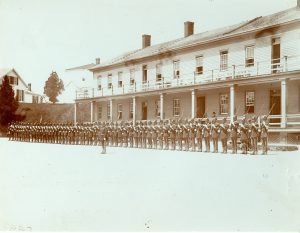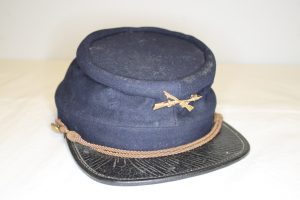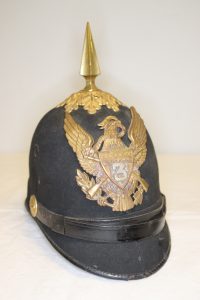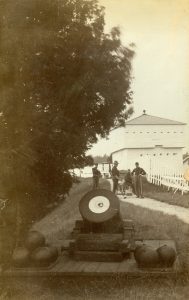
The public interacts with our interpretive staff every day, asking questions about the island, fort, and the way soldiers stationed at Fort Mackinac lived when it was active between the years of 1780-1895. One of the main draws, other than the rifle and cannon demonstrations, are the tours, given by interpreters seen in two types of uniforms: the everyday “undress” uniform and the more elaborate “dress” uniform. One of the unique aspects of Fort Mackinac in the 1880s is the balance between its soldiers serving in both military and public facing capacities, which almost perfectly matches the roles of their different uniforms. A big part of how Mackinac State Historic Parks makes sure to best tell the stories of these uniforms, and the soldiers that wore them, is though our collections. Headgear, especially for the uniforms that are worn at the fort, are vital to the overall story that the park tells the public. Two specific items that embody these uniforms are the forage cap and dress helmet.

The forage cap, or the wool, leather brimmed cap with unit brass on the front, is an evolution from the forage cap from the Civil War. Mostly worn by officers until 1872, when the whole army adopted them, these vital pieces of a uniform were more commonly seen used during daily duties in and around the fort. For more formal occasions, such as when the public was let in the fort several times a week, they had a different uniform: the dress uniform. This consisted of a frock coat, white gloves, dress collar, and the dress helmet. This helmet had both Prussian and British influences, with a brass eagle plate on the front, and a spike on top.

Both hats are unique in the way they help portray military life in the 1880s, as well as being some of the most recognizable items when the public comes to the fort. Having these items in our collections, furthermore, establishes the importance of public interaction with museums and their objects. Museum collections are often referenced for research, both public and private, and these hats hold significant value for those who want to learn more about the soldiers at Fort Mackinac. Items so easily identifiable and personal, such as these hats, aid in making that connection from the past to the present day, as these are the physical objects used daily by the people who served in the army in the 1880s.

Fort Mackinac, one of our premier sites, benefits from having several items in our collections pertaining to it and the soldiers that were there. Being able to have physical representations from that era, which visitors see daily, is history translated to the present day. They allow the public to get a look at our collections every day, but in the form of a personal aspect, through our interpreters. This makes the park a living representation of its objects, with the interpreters discussing their importance every day, and sharing their legacy with a wider audience. The kepi and dress headgear are vital to the park to tell these stories, as they are an iconic part of the uniform, fort, and overall encompass a crucial period in the islands’ history.









